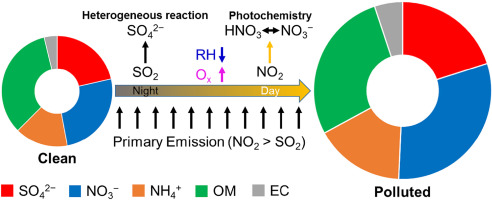Environmental Pollution ( IF 7.6 ) Pub Date : 2019-07-08 , DOI: 10.1016/j.envpol.2019.07.011 Siqi Ye , Tao Ma , Fengkui Duan , Hui Li , Kebin He , Jing Xia , Shuo Yang , Lidan Zhu , Yongliang Ma , Tao Huang , Takashi Kimoto

|
Changzhou, an industrial city in the Yangtze River Delta, has been experiencing serious haze pollution, particularly in winter. However, studies pertaining to the haze in Changzhou are very limited, which makes it difficult to understand the characteristics and formation of winter haze in this area, and develop effective control measures. In this study, we carried out continuous online observation of particulate matter, chemical components, and meteorology in Changzhou in February 2017. Our results showed that haze pollution occurred frequently in Changzhou winter and exhibited two patterns: dry haze with low relative humidity (RH) and wet haze with high RH. Water-soluble inorganic ions (SO42−, NO3−, and NH4+) accounted for ∼52.2% of the PM2.5 mass, of which sulfate was dominant in wet haze periods while nitrate was dominant in other periods. With the deterioration of haze pollution, the proportion of nitrate in PM2.5 increased, while sulfate proportion increased under wet haze and decreased under dry haze. Dry haze and wet haze appeared under slow north wind and south wind, respectively, and strong north wind or sea breeze scavenged pollution. We found that formation of nitrate occurred rapidly in daytime with high concentrations of odd oxygen (Ox = O3 + NO2), whereas formation of sulfate occurred rapidly during nighttime with high RH, indicating that photochemistry and heterogeneous reaction were the major formation mechanisms for nitrate and sulfate, respectively. Through the cluster analysis of 36-h backward trajectories, five sources of air masses from three directions were identified. High PM2.5 concentrations (84.1 μg m−3 on average) usually occurred under the influence of two clusters (46%) from the northwest, indicating that regional transport from northern China aggravated the winter haze pollution in Changzhou. Emission reduction, particularly the mobile sources, and regional joint prevention and control can help to mitigate the winter haze in Changzhou.


















































 京公网安备 11010802027423号
京公网安备 11010802027423号